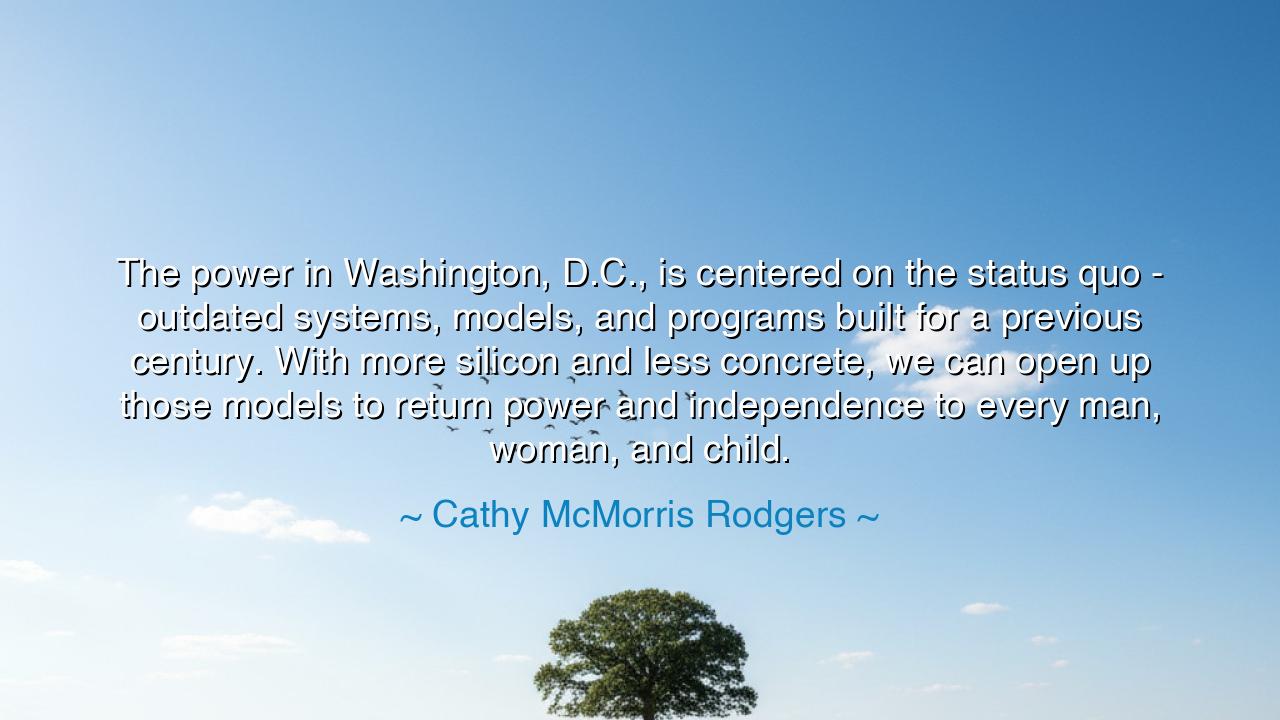
The power in Washington, D.C., is centered on the status quo -
The power in Washington, D.C., is centered on the status quo - outdated systems, models, and programs built for a previous century. With more silicon and less concrete, we can open up those models to return power and independence to every man, woman, and child.






The words of Cathy McMorris Rodgers ring with both urgency and vision, a call to awaken from the slumber of complacency. “The power in Washington, D.C., is centered on the status quo — outdated systems, models, and programs built for a previous century. With more silicon and less concrete, we can open up those models to return power and independence to every man, woman, and child.” In this declaration lies a timeless struggle — between the old and the new, between the rigid weight of bureaucracy and the boundless spirit of innovation. It is not only a political reflection, but a meditation on how civilizations must evolve or perish. For when institutions cease to serve the living, they become monuments to decay, and the future demands their renewal.
At its heart, McMorris Rodgers speaks of a truth older than the Republic itself: that power left unchallenged becomes petrified. The great cities of men, from Rome to Byzantium, fell not from external enemies, but from the erosion of vitality within. Systems built to protect freedom hardened into chains that bound it. The status quo, once a symbol of stability, became the seed of stagnation. And so, in every age, there must come reformers — those who see not only what is, but what might be. In her words, the call for “more silicon and less concrete” is not merely technological; it is spiritual. It is a plea to replace heaviness with agility, to embrace the creativity and speed of thought over the sluggishness of institution.
The origin of this quote arises from the shifting tides of modern governance. As the twenty-first century unfolded, nations built for the age of steel and steam found themselves ill-suited for the era of data and code. The digital revolution — the spread of technology, communication, and global interconnectedness — outpaced governments that still moved at the speed of paper and policy. McMorris Rodgers, a leader from Washington State, home to some of the world’s great technology giants, witnessed firsthand how innovation could empower individuals more effectively than any government decree. Her call was not a rejection of governance, but a restoration of its purpose: to serve, not to control; to liberate, not to restrain.
History gives us many mirrors for this truth. Consider the Renaissance, when Europe awoke from the long sleep of medieval rigidity. The thinkers of Florence and Venice, through art, mathematics, and science, broke the chains of the old world. Or remember the American Founders, who cast off the monarchy’s iron grip to build a republic based on liberty. In both cases, progress came not from preserving what was safe, but from daring to reimagine what was possible. McMorris Rodgers’s words belong to that same lineage of renewal — a reminder that every generation must tear down its own outdated fortresses of thought and build anew upon the open plains of imagination.
When she speaks of returning power and independence to every man, woman, and child, she evokes the original promise of democracy: that governance must never become the possession of the few. In every age, technology has held the power to either enslave or empower. The printing press spread knowledge beyond the church; the telegraph connected continents; the internet gave voice to the voiceless. But these gifts demand wisdom. “More silicon and less concrete” is not a call to worship machines, but to infuse progress with purpose — to ensure that technology uplifts the human spirit rather than replaces it. For in the hands of the wise, innovation is liberation; in the hands of the careless, it is tyranny reborn in a new form.
The status quo often hides behind the comfort of tradition. But the ancients knew that even the strongest walls crumble if they are not renewed. The philosopher Heraclitus said, “Nothing endures but change.” Those who cling to the old ways mistake permanence for safety. True permanence comes not from resisting change, but from embracing its direction with integrity. Thus, McMorris Rodgers’s vision is not destruction but renewal — to transform the monoliths of power into rivers that flow freely toward the people they were meant to serve.
And so, let this be the teaching drawn from her words: question the systems that no longer serve life. Do not fear the new simply because it unsettles the old. Let innovation be guided by ethics, and freedom by responsibility. Build institutions that breathe with the rhythm of the people — adaptable, transparent, and just. For the fate of any nation depends not on how tightly it holds its traditions, but on how courageously it redefines them.
In the end, the lesson is both ancient and eternal: progress without virtue leads to chaos, but stagnation without courage leads to ruin. The wise must walk the middle path — preserving the light of wisdom while tearing down the walls of fear. Let each generation, as McMorris Rodgers urges, find the courage to replace concrete with silicon, to trade bureaucracy for brilliance, and to return independence to every heart that beats within the body of the nation. Only then can the spirit of liberty remain alive — not as a relic of the past, but as a living promise to the future.






AAdministratorAdministrator
Welcome, honored guests. Please leave a comment, we will respond soon